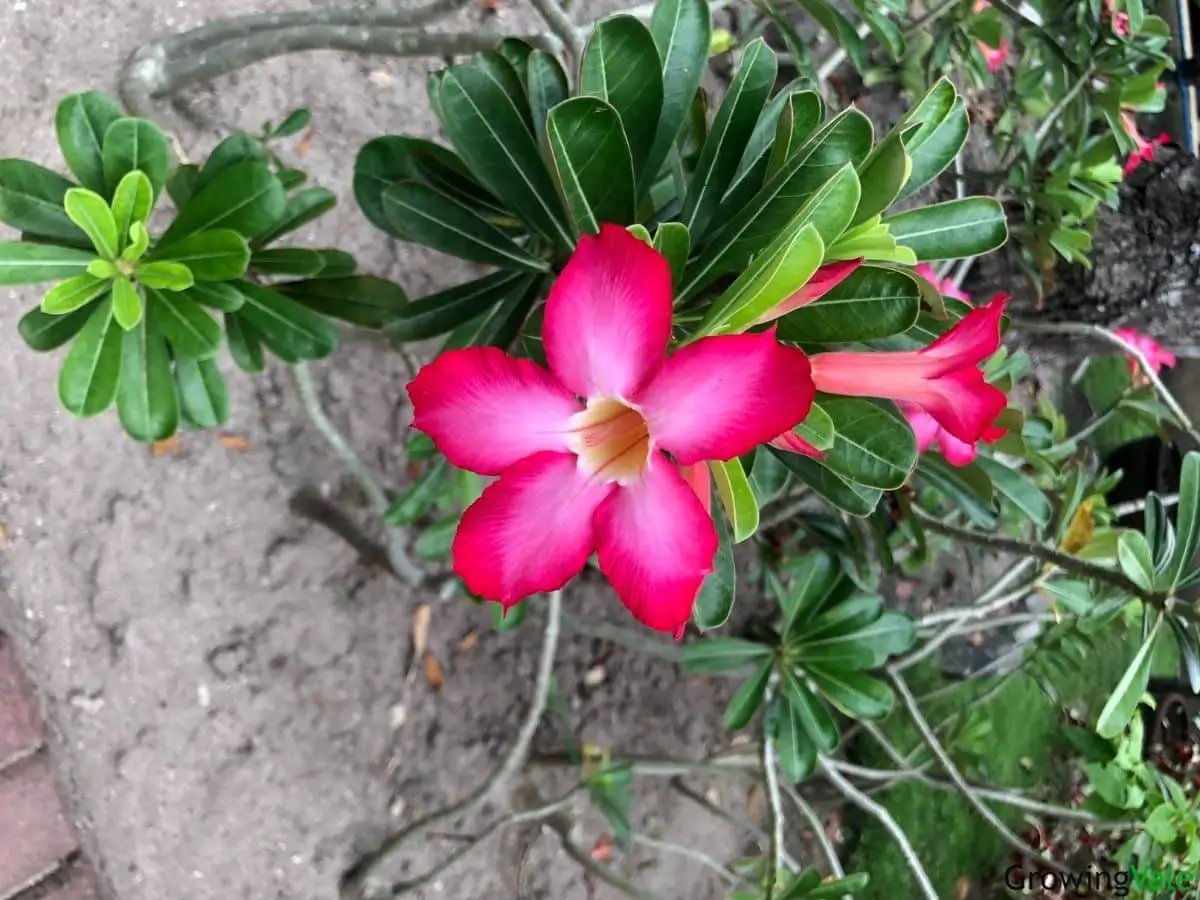Desert roses, which belong to the Adenium genus, are a group of flowering succulents that are prized by many gardeners for their beautiful and showy flowers. Unlike traditional succulents, desert roses have a delightful tree-like shape, making them extremely popular as indoor houseplants as well as outdoor containers and bedding plants!
Plants within this group are perennials that belong to the Apocynaceae family. Adenium is a small genus, with A. obesum being the most well-known of the group. These plants are particular favorites for containers in cooler climates and are often grown as bonsai trees.
History
Desert roses are native to dry regions in sub-Saharan Africa and the Arabian Peninsula, however, they are extremely popular in parts of Asia, Thailand and China in particular. In Thailand, they are believed to bring good luck, whereas in China, desert roses are called “fuguihua” or wealth plants, and are said to bring wealth to their owner!
Desert roses have been heavily cultivated and there are many wonderful Adenium species and cultivars with a range of beautiful colors and flower forms. Their lovely blooms are commonly pink, red, or white, but also come in delightful shades of purple, yellow, orange, and almost black!
Multi-colored varieties have also been bred, as well as double-flowered plants. In the wild some species can grow over 15 feet tall, but container-bound plants are much smaller.
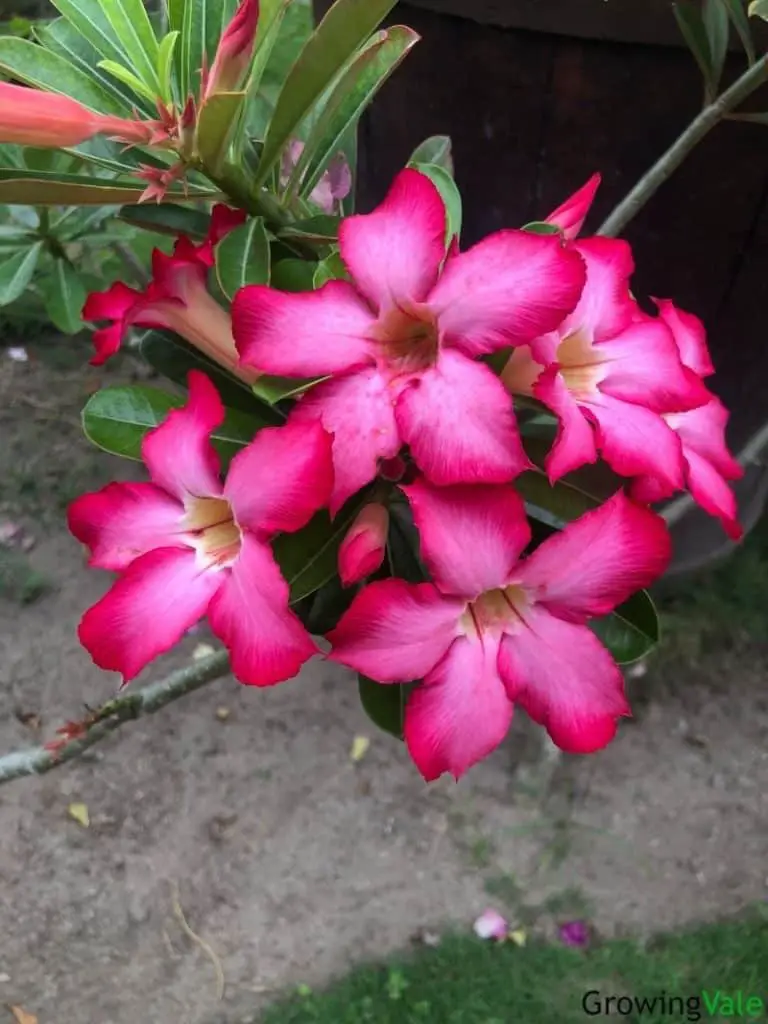
Plant Facts
| Scientific name | Adenium spp. |
| Common names | Desert Rose, Sabi Star, Mock Azalea, Dwarf Bottle Tree, Elephant’s Foot, Impala Lily |
| Genus | Adenium |
| Family | Apocynaceae |
| Height | 3 ft. 0 in. – 15 ft. 0 in. |
| Width | 3 ft. – 5 ft. 0 in. |
| USDA Plant Hardiness Zone | 10 – 12, depending on species and variety |
| Origin | Arabian Peninsula, Tropical Africa |
| Flower colors | Pink, White, Yellow, Red |
| Blooming season | Throughout the year, depending on climate and variety |
| Plant/Flower special features | Trumpet-shaped flower, suitable for bonsai |
How to Plant and Grow Desert Rose
Adeniums can be grown either directly in the ground or in containers. In cooler areas, growing them in containers is recommended as these tropical succulents will need to be brought indoors as soon as temperatures fall!
Make sure to place them in a sunny spot with well-draining soils. It is also best to replant or repot desert roses in spring, at the start of the growing season.
Growing Desert Rose Flowers in Beds
If growing desert roses directly in outdoor beds, first make sure that the climate is suitable, then pick a spot with the right amount of sunlight. Make sure the soil is well-draining, and if needed amend the bed. Bear in mind that these plants are susceptible to root rot so cooler climates that receive heavy, persistent rainfall may not be suitable!
Dig a hole large enough and wide enough to house the root ball, then ease it out of its existing container and plant it at the same depth as before. Gently pat the soil down around the roots and water them to settle in.
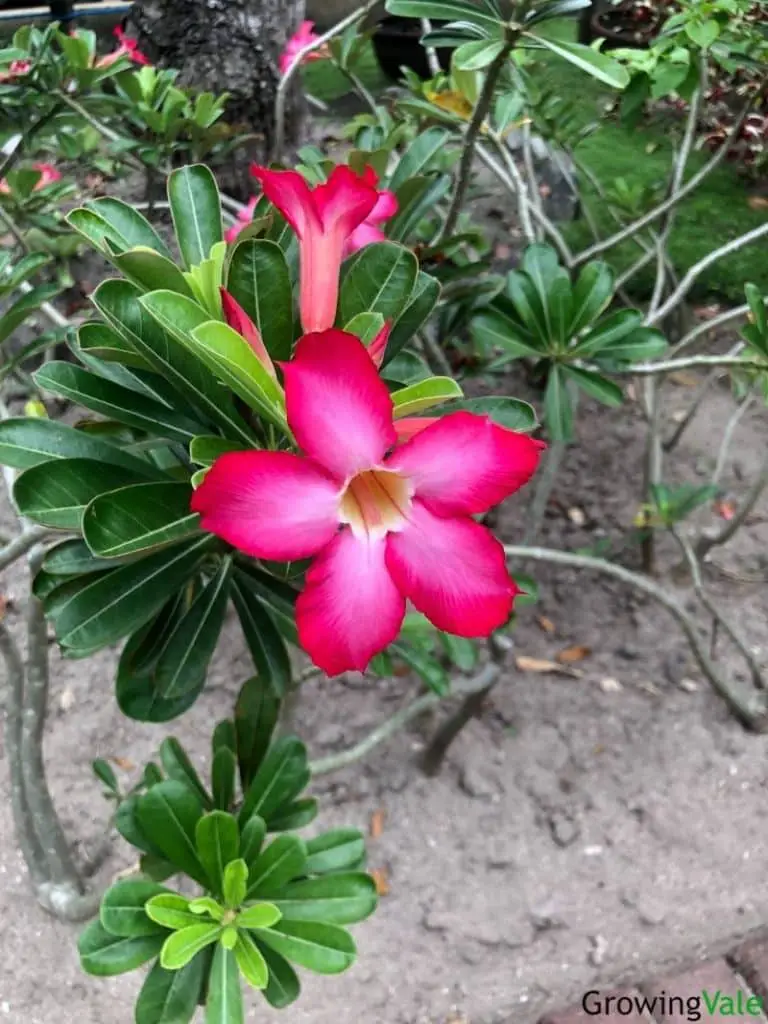
Growing Desert Rose Flowers in Containers
When growing these succulents in containers, determine how much room there is in the garden, patio, or balcony for the plant to grow, as well as how much space there will be indoors when overwintering.
Pot-bound plants will grow more slowly than those in beds, but for larger growth, choose a larger pot initially, or size up as the plant outgrows its container. These plants have large roots, so they can sometimes break through their container, leaving no choice but to repot them with more space!
Choose a clay or terracotta container with a good number of drainage holes and fill it with a 1:2 part mix of pumice and potting mix. Dig a hole large enough and wide enough to accommodate the root ball, and place them inside at the same depth as before, filling in and firming the soil around the base. Leave a 1-inch gap from the top of the container to the soil line to allow water to sink in.
Some gardeners prefer to place the plant with more of its caudex (the thickened underground base of the stem) or above-ground roots showing above the soil for visual impact.
How to Propagate Desert Rose Succulent
Adenium desert roses can be propagated either by seed or from rooted cuttings. Both methods have their pluses. Growing them from cuttings is easy and has a higher success rate; the cuttings will also be identical to the parent plant. On the other hand, plants grown from seed tend to have the best caudex, making this method better for container plants and the practice of bonsai.
Propagating Desert Roses by Seed
To grow Adenium plants from seeds, either collect seeds from existing plants or purchase them online. Purchasing them online is easier as these plants take years to reach maturity, and only form seeds under the right conditions. The seed pods are bean-like and should be left to mature before harvesting.
The seeds can be sown at any time of the year. Fill a seed tray or modules with moist seed compost made of 1:1 loam-based seed compost and vermiculite or perlite. Scatter the seeds on the top of the soil and cover them with a light sprinkling of vermiculite or perlite. Cover the container with either a plastic bag or place it in a propagator, keeping it in an area with bright, indirect sunlight and at a temperature of between 65 and 70°F. Keep the soil moist, but not overly wet!
Once the seedlings have their first true pair of leaves and are large enough to handle, gently prick them out and pot them up individually in small pots. They can now be grown at a slightly cooler temperature (60 – 65°F). Keep them well-watered, and while young, keep them in bright indirect light to avoid sunburn. Once they have developed 6 leaves (usually within a month) they are ready to be transplanted or repotted if desired.
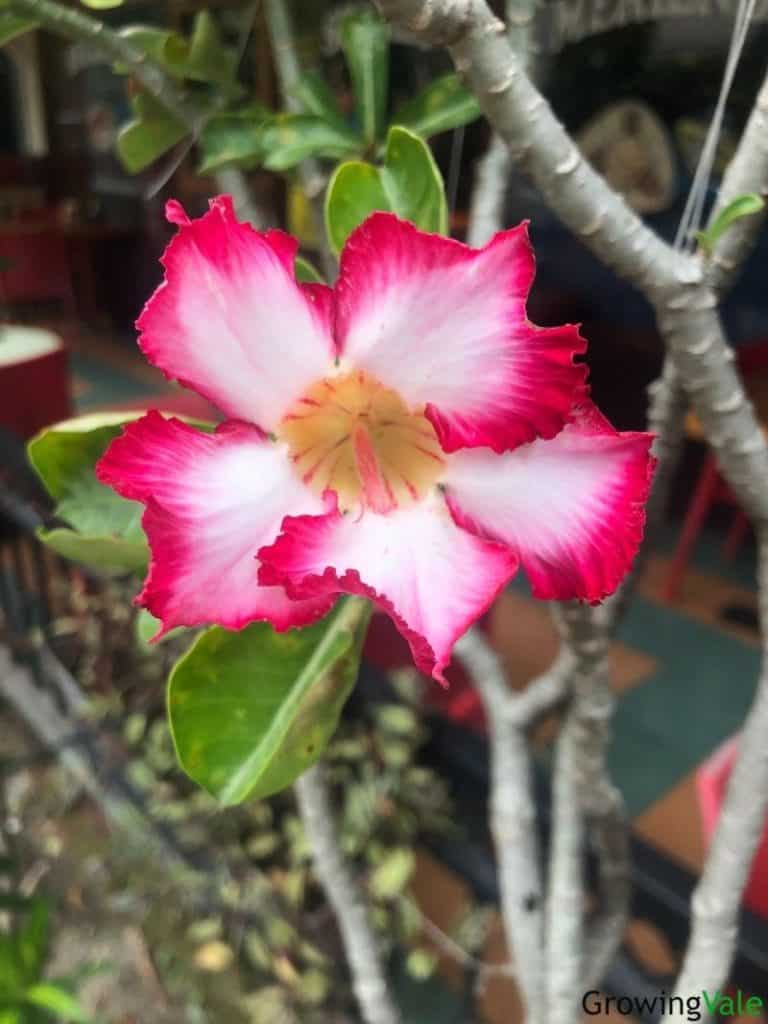
Propagate Desert Roses by Cuttings
To propagate desert roses from cuttings, take cuttings in the summer from non-flowering shoots. Use clean pruning shears to take a 2-4 inch long cutting from the tip of the shoot. Remove any lower leaves, and leave the cutting to dry out for 3 to 4 days. Once dried, dip the end of the cutting in rooting hormone, and plant in a container with moist seed compost made of 1:1 loam-based seed compost and vermiculite or perlite.
Place the container in a closed propagator with a bottom heat of 64-75°F, or for a simpler method, cover the container in a plastic bag and place in a warm place. Make sure to remove the plastic bag twice a week for ventilation. Place the cuttings in a bright spot with indirect light, and keep the potting mix moist but not overly wet.
The cuttings should be rooted within 2-4 weeks, however, in some cases, it could take a few weeks longer. Once rooted, harden off the cuttings for 2 weeks by gradually increasing their ventilation to get them accustomed to lower humidity environments. After this, they can be potted up individually in small pots.
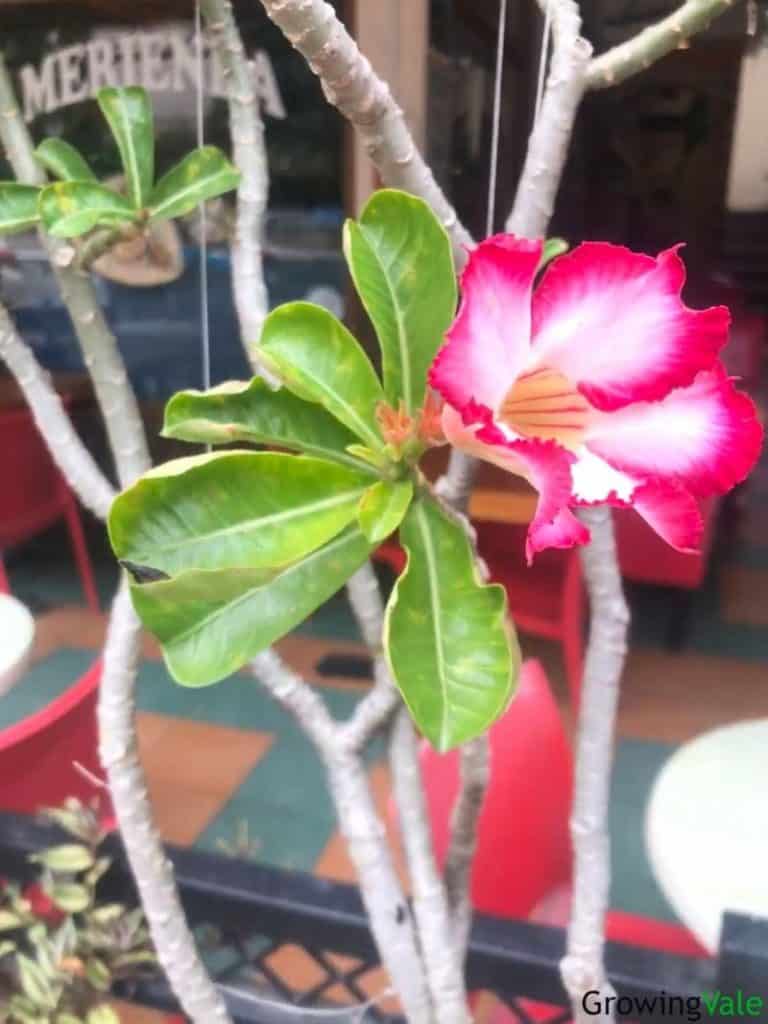
Care and Maintenance
Here are some handy desert rose care tips to keep your desert rose plants as healthy as possible:
Soil
Plant these succulents in well-draining, sandy or gravelly soils that mimic their native desert habitat.
Water
They are drought-tolerant but should be watered regularly during the growing season. However, make sure to allow the soil to dry out thoroughly between each watering.
Fertilizer
Fertilize the plants in spring during the growing season to promote flowering. Either use a slow-release fertilizer following package instructions or apply a balanced, complete fertilizer with micronutrients once or twice a month.
Sunlight
Desert rose plants should get at least 6 hours of direct sunlight a day, however, in particularly hot climates, most species and varieties perform better with some light afternoon shade.
Temperature and humidity
Since desert rose succulents are tropical plants and are winter hardy to USDA zones 10-11, they grow best in areas where the daytime temperature is between 80 and 90°F. In cooler climates, as soon as temperatures dip under 55°F, they should be brought indoors.
Pest and diseases
They are susceptible to root rot, so growing them in soils with sharp drainage is a must.
Be wary and keep an eye out for fungal leaf spots, aphids, mealybugs, and scales.
Pruning
Desert roses are popular bonsai trees and can be pruned without damage, however, pruning isn’t necessary. Some plants will naturally begin branching when they are smaller, whereas others may try to become tree-like. These types can be trimmed to keep them at a manageable size and to promote branching if desired.
Pruning to induce branching is best done in early summer during the peak of the growing season. Use clean pruning shears to cut off the top of the stem. The height of the stem does not matter.
Overwintering
In colder areas, container plants should be brought indoors over winter and placed in a sunny but cool location in the home. During this time water them thoroughly, but reduce the frequency of watering. If the plant goes dormant over winter (loses all of its leaves), then stop watering completely, even if this lasts for the whole winter.
Once the danger of frost has passed and temperatures rise above 55°F, place the plants back outside somewhere sunny.
Toxicity
Desert roses are toxic to people and pets so care should be taken in households with small children and animals. Ingesting any part of the plant, particularly the sap can cause vomiting, dizziness, heart problems, and even be fatal.
They have a white, milky sap that can cause contact dermatitis so be mindful when handling and wash hands thoroughly after touching or wear gloves.
Uses of Desert Roses
Desert roses are extremely popular for bonsai and also make wonderful container plants for patios!
Despite being toxic, these plants are highly valued medicinally, particularly in their native regions of tropical Africa and Oman. Like foxgloves, desert roses contain cardiac glycosides, which when given in low doses can treat congestive heart failure and problems with heart rhythm. Their latex is also applied topically to treat decaying teeth and septic wounds.
Common Varieties and Cultivars
Here are some popular and unique desert rose varieties, species and cultivars to add to your collection:
- Adenium arabicum – A. arabicum is a lovely succulent that can reach heights of over 16 feet! Its growing habit is short and fat with an enlarged caudex. This desert rose has wonderful flowers that appear from spring to fall in soft shades of pink to red.
- Adenium obesum – A. obesum is the most common desert rose flower and can grow up to 9 feet tall in their natural habitat, although pot-bound plants will be much smaller. These lovely plants typically have single, trumpet-shaped flowers that are red, pink, or rarely white, sometimes with a white central eye. This species has been highly cultivated and there are hundreds if not thousands of attractive cultivars!
- A. obesum “Golden Carrot” – Golden Carrot is a sensational cultivar that has showy, fully double flowers. Its flowers have slightly ruffled petal edges that form a sharp point at the petal tip. These petals are golden-orange spattered with crimson, have a crimson central stripe, and crimson edges. Depending on their environment, Golden Carrot flowers may have more/less red or orange coloration.
- A. obesum “Golden Millionaire” – This beautiful desert rose variety has fully-double rose-like flowers that would look sensational in a cottage-style patio or sitting on a coffee table indoors! Its blooms have creamy yellow petals that have a delicate raspberry pink central stripe!
Conclusion
The adenium desert rose plant is a succulent native to dry areas in tropical Africa and the Arabian peninsula. They are in the genus Adenium, with several species and hundreds of attractive cultivars! Adenium plants are a favorite among gardeners for their showy, trumpet-shaped flowers and tree-like structure that makes them ideal as indoor plants, outdoor patio plants, or bedding plants.
Luckily, these wonderful plants can be grown successfully in cooler climates as long as they are brought indoors over winter. For this reason, they are extremely popular as container specimens and are even kept indoors all year as pretty bonsai trees! However, Ademiums are toxic to people and animals so extreme care should be taken in households with pets and small children.
They have been bred heavily to produce hundreds upon hundreds of beautiful varieties. In the wild, desert roses are typically red, pink, or rarely white, but hybrid cultivars also come in purple, yellow, orange, almost black, and lovely color combinations. Their cultivars can also have attractive double flowers. With such a large variety, no matter the garden scheme, there is a desert rose that matches, and despite the care needed to keep this plant healthy in cooler climates, their showy blooms make it worth the extra effort!

